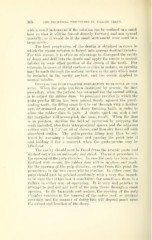Page 710 - My FlipBook
P. 710
368 THE TECHNICAL, PROCEDURES IN TILLING TEETH.
with a small instrument if the solution can be confined in a small
hole so that it will be forced directly forward and not spread
laterally, as it would do if the small instrument were used in a
large cavity.
The best penetration of the dentin is obtained in cases in
which the cocain solution is forced into normal dentinal tubules.
For this reason, it is often an advantage to disregard the cavity
of decay and drill into the dentin and apply the cocain to normal
tubules in some other portion of the crown of the tooth. For
example, in cases of distal surface cavities in molars, an opening
may be made through the occlusal surface in the area which must
be included in the cavity anyhow, and the cocain applied to
normal tubules.
Opening the pulp chamber peeparatoey to eemoval or the
PULP. When the pulp has been destroyed by arsenic, the first
procedure, when the patient has returned for the second sitting,
is to adjust the rubber dam. In proximal cavities in which the
gutta-percha filling has beeu placed firmly against the proxi-
mating tooth, the filling must first be cut through with a Koeber
saw, or trimmed away with a sharp finishing knife, in order to
allow the rubber dam to pass. A single, quick cut with a hot
flat burnisher will accomplish the same result. AVlien the dam
is in position, sterilize the field of operation by mopping the
teeth included, also their interproximal spaces and the adjacent
rubber with "1-2-3" or oil of cloves, and then dry them off with
absorbent cotton. The gutta-percha filling may then be sof-
tened by warming a burnisher and passing the point into it
and holding it for a moment, when the gutta-percha may be
lifted out.
The cavity should next be freed from the arsenic paste and
washed out with an antiseptic and dried. The next procedure is
the opening of the pulja chamber. In case the pulp has been anes-
thetized with cocain, the rubber dam will be in ]ilaee and ready
for the opening of the pulp chamber, so that from this point the
procedures in the two cases will be similar. In either case, the
pulp should first be pricked cautiously with a very fin(> broach,
to be sure that it has lost it sensibility, for sometimes there is a
failure in either way of operating. It is very bad practice to
attempt to ])nll out any part of the pul]} tissue through a small
opening. In the bicuspids and molars, the opening of tlie ]iulp
chamber consists in the removal of the entire roof, or dentinal
covering, and the miinner of doing this will depend iiiucli upon
the extent and location of the decay.


